Rachel Neumeier's Blog, page 287
November 4, 2016
Goodreads Choice Awards
File 770 very usefully encapsulates the four SFF genre categories included in the Goodreads Choice Awards, which are of course science fiction, fantasy, horror, and YA SFF.
I did vote in some of these categories, but it’s almost surprising how few of these books I’ve actually read. Or perhaps not, considering how busy I’ve been this year. Anyway, I’ve read exactly one of the SF novels (Bujold’s, of course) and have two as samples on my Kindle.
I’ve read two of the fantasy nominees (Patricia Briggs’ and Ilona Andrews’ entries), and have one on my wishlist.
I’ve read one of the horror — Dan Wells’ book — I really like this series and thought Over Your Dead Body was a good addition to it. I’m not sure I was thinking of it as horror, though.
And I’ve read just one of the YA nominees (The Raven King) and have one on my Kindle (Rebel of the Sands).
So if you’re a Goodreads member, you might like to click through and vote. And if you’re not, you might find it interesting to click through and see what’s on the award shortlist. To me it seems like a somewhat odd blend of super-popular authors and more literary types of stories. Of course the idea that some are more literary (Too Like the Lightning; All the Birds in the Sky) is based on what I’ve read about the titles, since I haven’t actually read the books (yet).
Please Feel Free to Share:









Recent Reading: SILENCE and TOUCH by Michelle Sagara
My goodness, now I so much want to read the third book! (GRAVE.) And it’s not out yet! Soon, though; February, if I recall what Amazon said about it. Sagara’s been taking her time with this trilogy, two years apart, but sometimes that happens.
Let me see, I believe I picked up the first book on the Free Books table at WorldCon.
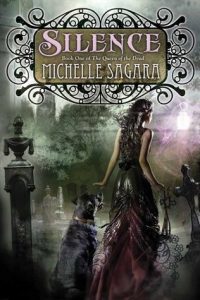
Good choice on my part; also a good tactical decision for the publisher (DAW) to spread some copies around considering the third book is due out early next year. I mean, I’ve preordered it.
Okay, I’ve only tried one other book by Michelle Sagara West, HUNTER’S OATH, and it was just okay for me. I liked this Queen of the Dead series a great deal better. It’s entirely different: contemporary YA with mostly one protagonist. Switching pov was something that didn’t work for me in the earlier Sagara West book, but the occasional scenes from other pov characters in this series were fine. Even the second-person prologue in the second book, which is certainly a tricky kind of thing to pull off.
So, let me orient you to this series: Emma is a Necromancer, or something like a Necromancer. In this world, Necromancers are pretty much totally evil. They chain the dead and draw on them for power. Also, because life is so short compared to death, they think nothing of killing people. What’s a few years if someone’s going to die anyway in the end?
At the top of the Necromancer food chain is the Queen of the Dead, who has closed off the way that the dead would take to (apparently) Heaven, in order (I presume) to keep them available so she and her Necromancers can use them as so many little power sources.
Okay, so as I say, that’s evil. But there are also people who oppose the Necromancers. Some of the hunters may be not quite ordinary human people. Some of the are just . . . really motivated. But they are not exactly knights on white steeds either. For one thing, they’re fine with killing people who might be recruited by the Necromancers, even if those people haven’t done anything nasty yet. For another, they are themselves completely unconcerned about the fate of the dead.
This is a “closed world,” so ordinary people don’t know about any of this. Certainly not Emma, until she bumps into an creepy ancient woman in a graveyard, is given a special gift, and wakes up a Necromancer. Or maybe not. It’s not clear whether Emma can chain and use the dead. It’s perfectly clear that she is totally opposed to the whole idea. She’s not real keen on the hunters, either, because they’re no more interested in the wellbeing of the dead than the Necromancers. What Emma wants is what any decent person would want: to free the dead.
What makes this book work:
The characters.
Emma is surrounded by friends; really good, solid friends; and by relatives; and by the relatives of friends. These books are really about friendship and parenthood and relationships.
“He’s not asking me to walk out on my Best Friend; he’s asking me to walk out on my own life. He’s asking me to be so afraid for my own safety that I’m willing to just leave you behind. And I could,” she added. “But it would change what friendship means – to me – forever. I could never, ever throw my whole heart into it, because if things were too dark or too scary, I’d know, in advance, that I’d be ducking, hiding, and running for cover. It’s not about you, really. It’s about me.”
Isn’t that wonderful? I wish I’d written those lines.
Anyway, I love how Sagara handles all the relationships in this book. It’s a crowded story: Emma and her mother and her father and her mother’s friend; Emma’s best friend Allison and her friend Amy and their friend Michael. And Eric and Chase. And a whole bunch of other less important characters. So as you see, a crowd, but Sagara brings them all to distinctive life. Also, Michael is autistic and I love the way he is such an intrinsic part of the inner circle of friends. Also, I can’t decide whether Amy really has some kind of superpower that has nothing to do with necromancy or not, but I love the way Popular Girls and Bookish Girls are both positively presented.
Also, Petal. That is such a ridiculous name for a Rottweiler. I really enjoyed both the dog and his name, and since we were just on the dogs-in-SFF topic, here you go, another fine example.
The conflict.
It’s not just the conflict between the Necromancers, who want to forcibly recruit Emma and incidentally keep on using the dead as though they were mindless electric plugs; nor the conflict between the Necromancers and the hunters, who are inclined to kill Emma to keep her from being recruited. It’s Emma’s deep conviction that the thing to do with ghosts is set them free and most definitely not leave them lost in memories of their various deaths.
But there’s also conflict embedded in that, since Emma’s deceased father is not planning on going anywhere until his daughter is safe. And her deceased boyfriend still loves Emma, but is desperately vulnerable to the Queen of the Dead. This story has plenty of action, but you see it really is all about relationships: parent-child relationships as much as any others.
The writing
The writing is invisible and disappears into the story. Even in the second-person bit, the writing doesn’t draw attention to itself. The worldbuilding is interesting, and with a closed-world contemporary setting, the books are easy to get into. There is some romance, but the angst level is minimal given the deceased boyfriend.
If you don’t mind using the term noblebright while we work to come up with something less corny sounding, then these books could practically define the genre.
As I said, I preordered the third book as soon as I finished the second. It’s going on my top ten most-anticipated list for next year.
Please Feel Free to Share:









November 3, 2016
Top ten dogs in SFF
Okay, in answer to the list of cats, here goes with a list of dogs! This is not so much a top-ten list as just a list because I had trouble thinking of more than ten dogs. I’m sure I’m missing some. (A lot, probably.) I wanted to stick to dogs, no wolves, because personally I hate it when someone throws a wolf into a story and it is plainly a DOG and NOT A WOLF. (Jean Auel, I’m looking at you.) (But Auel is hardly the only who’s done this.)
Anyway, dogs only in my list!
But having said that, I’m willing to stretch a point for stars that get incarnated as dogs because my favorite dog of all time is:
1. Sirius in DWJ’s DOGSBODY.
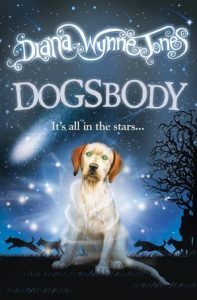
Really, you cannot beat Sirius. Such a wonderful story. I look back at it in awe because who but DWJ could possibly have thrown stars as characters, dogs, the Wild Hunt, and a serious story about Kathleen and the prejudice against the Irish all into one story and made it work?
2. Robin McKinley, for the saluki-like dogs in DEERSKIN and all the many dogs in SHADOWS. The dogs get to be real characters in the former, but I enjoyed the dogs in the latter as well.
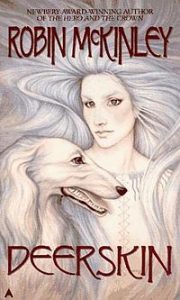
3. Barbara Hambly’s wonderful THE BRIDE OF THE RAT GOD actually made me fall a little bit in love with Pekingese, not ordinarily my favorite breed (sorry, Pekingese lovers; just a personal preference). Do NOT be misled by the title, which is deliberately B-movie campy. The story is delightful and the three Pekingese are real characters, real dogs, and also btw capable of hunting demons if any should turn up.
4. Doranna Durgin has written some great dogs, especially the corgi — Cardigan rather than Pembroke, don’t see that very often — in A FERAL DARKNESS and all the hounds in SEER’S BLOOD. Dog lovers should definitely find copies of both books.
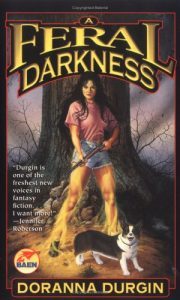
5. Ilona Andrews wrote a great standard poodle into her (their) Kate Daniels series. Sure, he turns into a giant hellhound kind of creatures sometimes, but most of the time he’s a Real Dog. Also, I’m a great fan of standard poodles, so that choice of breed delights me.
6. Patricia Briggs throws some dogs into FIRE TOUCHED, one of the more recent Mercy Thompson stories. Hellhounds and stuff but also real dogs.
7. The Odd Thomas series by Dean Koontz features Boo, a ghost dog, as a fairly important continuing character.
8. Tamora Pierce’s BEKA COOPER series features not only the cat that is really a god, but also a dog that is really a dog. A scent dog, very appealing; not to mention useful for a young cop.
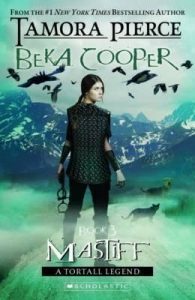
9. On a somewhat darker note, there’s Blood in “A Boy and His Dog” by Harlan Ellison. Not exactly my favorite story ever, but memorable.
10. And . . . I’ll just mention THE WHITE ROAD OF THE MOON. I happen to like the dog in that one, too.
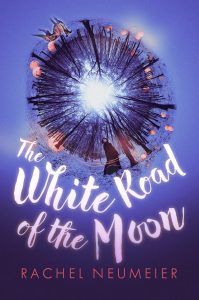
Please Feel Free to Share:









November 2, 2016
The 25 best cats in SFF
Here’s a post at Barnes and Noble: The 25 best cats in science fiction and fantasy. Always a good topic, though I’m inclined to do a matching list for dogs. Still, click through if you’re so inclined and let’s take a look.
Okay, not all these cats are cat-cats. Aslan, for example; and the hani from Cherryh’s Chanur series; and David Webber’s “treecats,” which are, being alien, even less real cats than, say, a marsupial “tiger cat.” Cats, really?
Many of the more catlike cats on the list, I’ve never encountered. But this one sounds like my favorite kind of cat:
Slag in the The Tales of the Ketty Jay series, by Chris Wooding
Slag is the feral cat that lives on Captain Darian Frey’s ship, the Ketty Jay. He’s just a cat. He doesn’t talk, or have magic powers, and rarely has a direct connection to the main plot of Wooding’s arch, fun SFF series (ideal for anyone missing Firefly). But Slag entertains, and often offers a perspective—especially in his popular POV chapters—that illuminates the situation of the crew in ways that feel refreshing and unobtrusively informative in ways that no other character could achieve.
A real cat! I actually like that better than (most) talking cats or (most) catlike beings. Also, saying a series would appeal to Firefly fans does make me feel like looking it up.
I know there are a LOT of SFF cats missing from this B&N list. But at the moment I can’t quite think of which cats are missing.
However, I know what possibly the weirdest cats ever in SFF might be: Mother Hutton’s Littul Kittons There’s a pdf version here.
Though of Cordwainer Smith’s cats, I liked the ones in “Game of Rat and Dragon” better. You can read that story here, if you’re interested.
Who’s your very favorite cat in SFF? Or — let’s open it up — in all of literature? Drop a cat in the comments, please!
Please Feel Free to Share:









November 1, 2016
Recent Reading: THE LOST by Sarah Beth Durst
Okay, anybody know the story behind what happened with this series and whether it’s likely to be completed in the semi-near future? Because there’s an excerpt from the second book in the back of this ARC, but evidently the second book was never actually published. Very odd. THE LOST came out from Harlequin, btw, so it’s not like they went unexpectedly bankrupt, I presume. Whatever happened, the publisher likely still holds the rights to the first book, which may be why Durst hasn’t moved ahead with self-publishing the second.
But! All this oddness aside, actually the first book is self-contained and reads perfectly well alone, so there’s no reason not to pick it up if you think it should intriguing. I liked it a lot, personally.
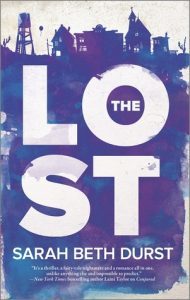
Things I lost:
a stick of Chapstick
a few quarters
one turquoise earring, a gift
my old college roommate’s new phone number
my left sandal
Mr Rabbit, my favorite stuffie from my preschool years
my way
Things that are lost wind up in the town of Lost, including foreclosed houses, a good many wallets and pieces of luggage, and the sandwich you put down after taking a bite and a dog ran off with it while your back was turned. A lot of dogs, for that matter, and not a few children, so this town is not a particularly sweet or fairy-tale kind of place.
On one particularly bad day, Lauren didn’t turn left at proceed on her familiar way to work. She drove straight on and straight on, until she lost her way and herself and wound up in Lost. The denizens of Lost tend to be rather creepy. Some of them lost something important, generally something metaphorical, and are stuck until they find it. Some of them may be dead. None of them can leave without the help of the Missing Man . . . I never did understand why he would be called that. He’s a creepy figure.
Besides the Missing Man, there’s a Peter Pan analogue: a grown-up sexy Peter who tends to speak in snatches of poetry. This is not even faintly a Peter Pan retelling, however, though I’m sure the name Peter was chosen deliberately.
So you can see the basic outline of the story from these elements. There’s more to it. Lauren needs to find what she lost; she also needs to understand her potential role in the town of Lost. She also needs to sort out what Peter means to her, or might mean. I don’t want to give too much away, so I’ll leave it at that. I will say, though, that Lauren seems:
A) Somewhat slow to catch on; I was pretty impatient with her for a while.
B) Mysteriously gifted for reasons that don’t become clear in this book. A lot of things don’t become clear in this book.
C) Still, Lauren is an engaging protagonist who grew on me as the story unrolled. But for me the little girl, Claire, stole the show.
D) The ending, despite whatever derailed the second book, is pretty much perfect.
Please Feel Free to Share:









October 31, 2016
Happy Halloween!
Just as Twitter’s main purpose is to send around cat pictures, now that I’m using Facebook I find one of its main pleasures is the flood of cool pictures of all types. Here are a couple I’ve seen lately and that I’ve been saving for Halloween:
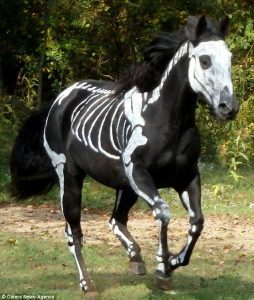
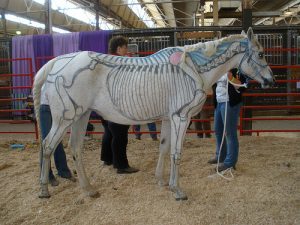
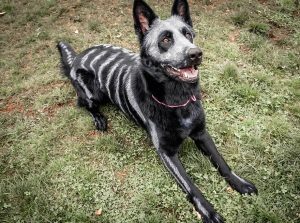
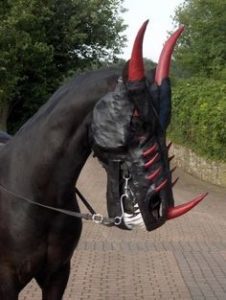
Aren’t these wonderful? Wouldn’t you totally do something like this if you had a black horse? And then dress up as DEATH and ride it around?
Also, these wonderfully costumed kids. What a splendid idea!
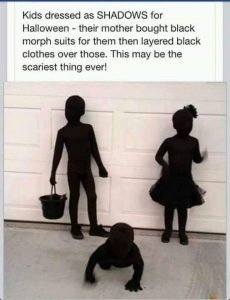
And this is not a costume, but OMG don’t you want this?

Actors rehearse with the French mechanical installation “LongMa”, which means a fine horse in the shape of a dragon, during a press conference at the center of the Olympic Green in Beijing on October 10, 2014. The French mechanical “LongMa” performance will be presented at the center of the Olympic Green in Beijing to mark the 50th anniversary of the establishment of diplomatic relations between China and France. AFP PHOTO / MANDY WANG

There are many fine video clips of the dragon horse online. As a Halloween treat, take a few minutes to google around and admire this beast. If I were writing a steampunk story, I would so include a thing like this.
Please Feel Free to Share:









October 28, 2016
Special Halloween Sale
Just for this Halloween weekend, I’m dropping the ebook price of BLACK DOG to 99c. Here’s the Amazon link, but all venues should be offering the .99c price already or at least by tomorrow morning at latest.
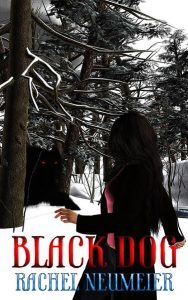
If you don’t already have a copy, this would be the time to pick it up!
Please Feel Free to Share:









The Gone Girl With the Dragon Tattoo on the Train
Here’s an interesting post by Emily St. John Mandel at FiveThirtyEight: The Gone Girl With The Dragon Tattoo On The Train:
There was a time a few years back when it seemed to me that about every third book I encountered was called “The X’s Daughter,” with X standing in for just about any occupation, title, rank and pejorative imaginable. Bookshelf upon bookshelf was filled with the daughters of generals, cartographers, lacemakers, lighthouse keepers, veterinarians, preachers and miscreants.
More recently, we seem to have entered the age of the girls. Paula Hawkins’s debut, “The Girl on the Train,” was published last year and is still everywhere: Nielsen BookScan reports 2.7 million copies have been sold in the U.S. — the actual number is undoubtedly much higher, because that number doesn’t capture eBook sales — and box-office receipts for the film adaptation reached nearly $25 million in its opening weekend. Gillian Flynn’s “Gone Girl” was equally ubiquitous a couple of years back. This summer belonged to “The Girls,” Emma Cline’s acclaimed debut novel, still prominently displayed in every bookstore I enter. Carl Hiaasen’s “Razor Girl” recently hit The New York Times bestseller list.
Yes, I remember many comments about the “daughter” phenomenon. I’m not super-keen on any of these titles, btw. I’m like: can we focus on the protagonist instead of her father? Gillian Bradshaw’s The Bearkeeper’s Daughter (which came out, of course, ages before the Year of the Daughter), was titled in a kind of misleading way, since in fact the story was not about Empress Theodora, but about her son. I never have liked that title, though I loved the book.
And now with these Girl books. At least the title focuses on the protagonist. I assume. I haven’t read any of them except The Girl with the Dragon Tattoo. But why all the Girls?
People I spoke with in the publishing industry theorized that the Girl phenomenon started with Stieg Larsson’s Millennium series — “The Girl With the Dragon Tattoo,” “The Girl Who Played With Fire,” “The Girl Who Kicked the Hornet’s Nest,” “The Girl in the Spider’s Web.” That had been my assumption, too, but it appears the share of books that had “girl” in the title had already been rising before the first Millennium novel was published in the U.S. in 2008. (It was published in Sweden under a different title in 2005.) This year is shaping up to be the biggest year for ‘girls’ in fiction in decades, with nearly 1 percent of fiction titles featuring the word ‘girl’ in the title, according to Goodreads’ analysis.
Wow.
Anyway, Emily St. John Mandel goes on to provide graphs and statistics and analyses and the whole thing is quite interesting. Proportion of “Girl” books written by men rather than women; proportion of “Girl” books where the titular girl dies, all kinds of things. One question I had wondered about is answered: About 2/3 of the “girls” from the title are actually women. Yeah, I personally am not keen on that. I hate being called a “girl,” even by other women. Here’s a note on that subject:
I [St John Mandel] asked my editor at Knopf, Jennifer Jackson, if she had any thoughts on the trend. “Maybe ‘girl’ hints at a vulnerability that raises the stakes,” Jackson suggested, “or an inevitable growing up in a way that promises story?”
I don’t know, could be. Those reasons almost sound justifiable. I still detest being referred to as a “girl” though.
What about it: if you’re browsing new releases that you haven’t heard about, would you be more or less inclined to pick up and look at the first page of a book with “Girl” in the title? Or would your browsing choices depend entirely on other things, like cover?
I personally prefer evocative, poetic titles (The Knife of Never Letting Go, say) and covers with plenty of color to them.
Please Feel Free to Share:









October 26, 2016
Just in time for Halloween: Black Dog stories
Even if you never go any further than putting a pumpkin on your front porch — which is about my level of attention to Halloween, since we don’t get trick-or-treaters out where I live — naturally you MUST HAVE a new book suitable for the season, right?
Right!
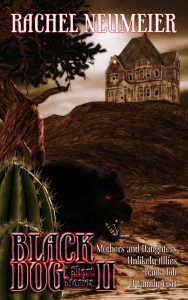
This ebook collection includes novelettes and two novellas, plus a “nonfiction” essay:
1. Mothers and Sisters
Before the failure of the miasma that hid all supernatural darkness from the sight of ordinary humans, brutal black dogs sometimes ruled as kings—sometimes for generations. In a country where black dogs rule and the Pure are despised, even a girl as fierce and determined as Keziah finds life a precarious struggle. But after her little sister is born, she has so much to fight for…
This is a prequel novella, set well before the beginning of Black Dog.
This novella is significantly darker than most Black Dog stories. Though content is not graphic, it may not be suitable for all readers.
2. Unlikely Allies
Ezekiel is on his own when he discovers an entrenched enemy with a particularly unpleasant plan to supplant and destroy Dimilioc. To defeat this enemy, Ezekiel needs an ally…even a man who might turn on him before the end.
This novelette is set after the events of Pure Magic.
3. Bank Job
Living and working with a lot of stray black dogs is a real trial for Ethan Lanning, especially since not even the best bloodlines and training gave him the kind of strength a Lanning ought to possess. But when a mission gets complicated, Thaddeus might be just the right guy to have at his back after all…
This novelette is set after the events of Pure Magic.
4. A Family Visit
Just an ordinary Christmas with his grandmother, that’s all Justin has in mind. Sure, it’s a little awkward that Grayson insisted Keziah keep him company on the trip, but everything will be fine once they get to know each other. But Justin never expected to arrive only to discover his grandmother has vanished from her home…
This novella is set after the events of Pure Magic, directly before the opening of Shadow Twin (forthcoming).
5. Witches and Witchcraft
A peek into the secret history behind the world of Black Dog
So that’s the ebook. But! If you don’t care for ebooks or you prefer paper or you’d like all the stories so far collected in one place, here you go:

The print version! Obviously this is basically the same cover, but if you look carefully you will see it says “I & II” on the front and lists all the stories on the back.
I’m totally counting this print collection as a Real Book! It’s hard to know how to count shorter work, but the total wordcount of the combined Black Dog stories is roughly 109,000 words, so you see it is definitely book length. That makes this my tenth published book and MOUNTAIN will be my 11th. Not bad for eight years!
Please Feel Free to Share:









Middle Grade vs Young Adult
So, before KidLitCon, I wandered around the internet a bit, looking to see what different people think defines MG vs YA. Here is a compilation of what I found, based on the opinions of various publishing professionals, editors, booksellers, and bloggers:
Middle Grade:
Shorter than Young Adult, usually 20,000 to 50,000 words.
Is more readable for less advanced readers.
Features a protagonist fourteen or younger.
Deals with edgy or difficult topics secondhand; if someone is suffering from depression or anorexia or whatever, it is a sibling or parent, not the protagonist.
Is more concrete and focuses on family, friends, and ordinary difficulties.
The child’s life is still fairly tightly controlled by the parents or parental figures.
Has a lower top end for darkness.
At the end of the story, the protagonist is still a child.
Sales are driven by appealing to school buyers and other adults.
Young Adult:
Longer than MG but shorter than Adult, usually 50,000 to 80,000 words.
Is written to appeal to more advanced readers.
Features a protagonist between fifteen and nineteen.
The protagonist is often the one dealing with some edgy or difficult condition or situation.
Is more focused on how the protagonist affects the broader world, but the experience and growth of the protagonist is central.
Features a broad range, from “light” to quite dark.
At the end of the story, the protagonist has moved from childhood to adulthood.
The story is narrated with immediacy from the perspective of the teenager.
Sales are driven by word-of-mouth.
What do you think? How plausible does all that seem to you? I can think of SO MANY EXCEPTIONS to every criterion except the age of the protagonist, which can’t help but make me doubt the whole thing.
I guess acquisitions editors need guidelines to help them make buying decisions, and agents need guidelines to help them decide what to send to which editor, and writers need guidelines to have some clue what to aim for when they’re starting a new project. But I suspect that everyone actually operates off an I-Know-It-When-I-See-It gut feeling.
The length guidelines seem seriously doubtful, to start with. I know that SFF tends to push length limits no matter whether it’s MG or YA or Adult, but still, the guidelines given above seem remarkably off compared to what I actually have in my personal library.
I have exactly one set of MG stories that seems to fit the given length: The military dog stories by C Alexander London that I picked up at KidLitCon. Estimating the word count by multiplying the average number of words per line times the number of lines times the number of pages, these seem to come in right about at 50,000 words, which you’ll note is right at the very tippy-top of the suggested length. Here’s what I get for other MG stories I’ve read:
Merrie Haskell’s The Princess Curse — 61,000 words; Castle Behind Thorns — 60,000 words, and I know that latter number is correct because I have a rough draft in Word and I just opened it up and looked.
Cat Valente’s The Girl Who Circumnavigated Fairyland — 72,000 words
Sarah Prineas’s Winterling — 64,000 words
DWJ’s Howl’s Moving Castle — 75,000 words
Nancy Bond’s A String in the Harp, published 40 years ago, 128,000 words. Yes, really. It’s interesting to compare font size and the number of lines per page in that book to current novels – I mean, there is no comparison. I don’t think you ever see a MG story now with such small type.
Moving on, here’s what I get when I estimate wordcounts for a more-or-less random selection of YA. Actually, I’ll start with all mine because I know the wordcounts for sure. Remember the top length is supposed to be 80,000 words.
The City in the Lake — 81,000 words; The Floating Islands — 108,000; The Keeper of the Mist — 119,000; Black Dog — 125,000; The White Road of the Moon — 112,000.
Now, when I used the words x lines x pages estimation, that method underestimated the actual length of my own books by 6% to a whopping 15%. So I think we can be fairly sure that if I’m off with the actual estimations, it’s because the actual wordcount is higher, not lower. So, with that in mind, other YA novels:
Sarah Prineas’s Ash and Bramble — 109,000 words
Elizabeth Wein’s Code Name Verity — 110,000 words
Maggie Stiefvater’s The Dream Thieves — 100,000 words
Suzanne Collins’ The Hunger Games — 87,000 words
So, those length guidelines don’t seem very accurate, at least not for SFF, but see how Wein’s historical also overshoots. I will point out that my debut YA comes the closest to hitting the supposed upper limit of 80,000 words. I was specifically aiming to write a short standalone novel because I thought it would improve my chances of traditional publication. Still, I have no reason to think that The Floating Islands wouldn’t have found a home just as fast.
Now, how about all the other guidelines?
I have not actually read very many MG I can think of where the children’s lives were “fairly tightly controlled by their parents” or “focused on ordinary, concrete concerns.” Merrie Haskell’s, no. Sarah Prineas’s, no. Sage Blackwood, no. In many DWJ novels, no. Granted, in The Lives of Christopher Chant and various other DWJ novels, parental figures exert more control, or at least influence. But in the Wings of Fire series, hah hah hah, no. In fact, Sutherland’s series stands out in other ways, too. At the end, the characters have grown up, for one thing, which is supposed to be much more a thing for YA.
As for darkness, grittiness, realism, all that stuff, surely there truly must be a greater range in YA and a good many more books must land on the darker side of the spectrum. But I wouldn’t say a writer aiming to write for a YA audience needs to aim darker. It might seem that way sometimes when, say, dystopias are particularly big. And there does seem to me to be a tendency for industry professionals to try to shove all YA toward a narrower part of the spectrum – it has to be focused on angsty relationships, it has to have an important romance component, it has to be dark. But I think that impression may be exaggerated by confirmation bias. I suspect that actually YA has spanned the whole light/wonder to dark/gritty spectrum from its inception as a marketing category, and still does, even when it seems that angst has consumed the whole category.
Even the ages of the protagonist are not set absolutely in stone, though certainly I would really love to see a stake driven through the heart of the idea that young readers can’t, or shouldn’t be asked to, identify with older protagonists. Doing their part: Code Name Verity and Rose Under Fire. The ages of the protagonists and other characters are never specified, but one hardly gets the sense they are teenagers. That’s very, very rare in YA. I would like to see it more often.
Please Feel Free to Share:












